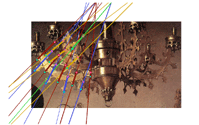
« PREVIOUS ENTRY
“Grassroots industrial design”: My latest Slate column
NEXT ENTRY »
Hey kids! Free lunch!

A year ago, I blogged about David Hockney’s controversial book — which argues that the secret behind the explosion of realism in the Renaissance was the camera obscura. Hockney thinks the old masters were using cameras obscura to project their subjects onto canvases, and then traced them from life.
But now there’s a rebuttal, from two computer scientists. David Stork and Antonio Criminisi did a close analysis of the chandelier in “Portrait of Arnolfini and His Wife” by Jan van Eyck. Their verdict? Not that realistic, according to The New York Times:
The problem, as Mr. Stork and Mr. Criminisi see it, is that the chandelier in the Arnolfini portrait is hardly painted in perfect perspective. Relying on digital image registration techniques, Mr. Stork and Mr. Criminisi applied projective geometry to one of the arms of the Arnolfini chandelier to see what the others should look like given the various angles that the painter would have seen them from. Then, as Mr. Criminisi described it during a phone interview yesterday, each painted arm was compared with its ideal perspectival projection; they were not identical.
You can read Stork and Criminisi’s paper here online — and check out their way-kewl illustrations showing how the vanishing point for the perspective on the chandelier is slightly off.
I'm Clive Thompson, the author of Smarter Than You Think: How Technology is Changing Our Minds for the Better (Penguin Press). You can order the book now at Amazon, Barnes and Noble, Powells, Indiebound, or through your local bookstore! I'm also a contributing writer for the New York Times Magazine and a columnist for Wired magazine. Email is here or ping me via the antiquated form of AOL IM (pomeranian99).

ECHO
Erik Weissengruber
Vespaboy
Terri Senft
Tom Igoe
El Rey Del Art
Morgan Noel
Maura Johnston
Cori Eckert
Heather Gold
Andrew Hearst
Chris Allbritton
Bret Dawson
Michele Tepper
Sharyn November
Gail Jaitin
Barnaby Marshall
Frankly, I'd Rather Not
The Shifted Librarian
Ryan Bigge
Nick Denton
Howard Sherman's Nuggets
Serial Deviant
Ellen McDermott
Jeff Liu
Marc Kelsey
Chris Shieh
Iron Monkey
Diversions
Rob Toole
Donut Rock City
Ross Judson
Idle Words
J-Walk Blog
The Antic Muse
Tribblescape
Little Things
Jeff Heer
Abstract Dynamics
Snark Market
Plastic Bag
Sensory Impact
Incoming Signals
MemeFirst
MemoryCard
Majikthise
Ludonauts
Boing Boing
Slashdot
Atrios
Smart Mobs
Plastic
Ludology.org
The Feature
Gizmodo
game girl
Mindjack
Techdirt Wireless News
Corante Gaming blog
Corante Social Software blog
ECHO
SciTech Daily
Arts and Letters Daily
Textually.org
BlogPulse
Robots.net
Alan Reiter's Wireless Data Weblog
Brad DeLong
Viral Marketing Blog
Gameblogs
Slashdot Games